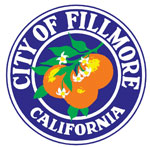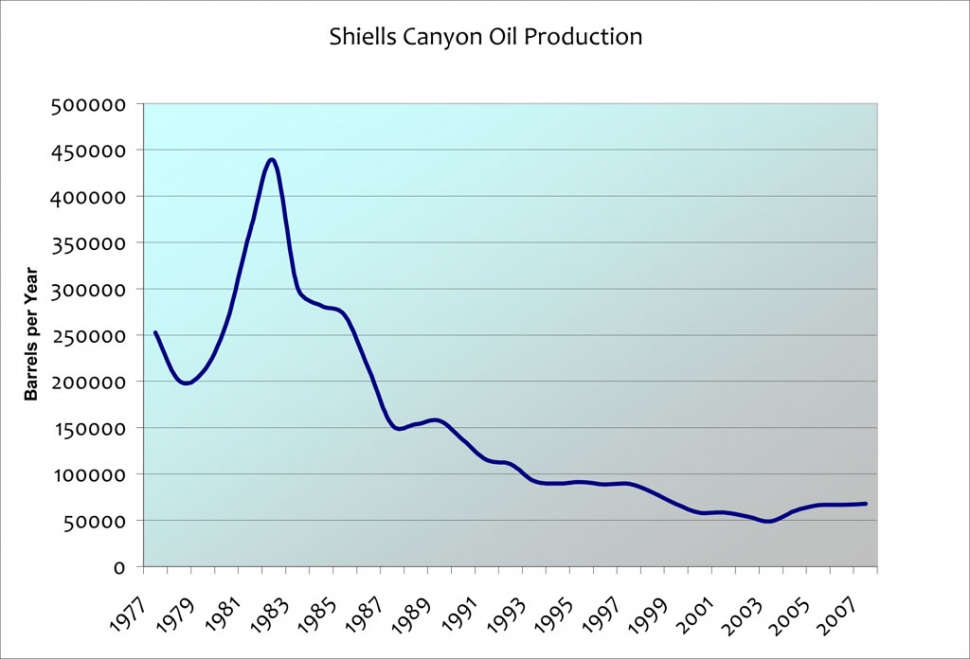|
Fillmore…A Work In Progress
By Joyce Schifanelli — Wednesday, November 5th, 2008
Part Two
 City of Fillmore  Shiells Canyon Oil Production. Joseph D. McNab’s farseeing vision of Fillmore in the late 1800s and the town’s early success in business and ranching was a product of a splendid, bountiful valley of Prime agricultural soil, sound planning, and the determined pioneering spirit of its settlers. Trains, the engine responsible for opening the area, carried passengers and freight through the valley and beyond. With accessible transportation, Fillmore’s reputation grew as a great place to earn a good living and raise a family. Nevertheless, with increasing popularity of automobiles in the early decades of the twentieth century, passenger train service decreased. The last passenger train stopped at our station on January 13, 1935, marking the end of an exciting era, and refrigerated trucks soon replaced freight trains laden with the fruits of our valley. Alas, the Southern Pacific Company closed down the Fillmore stop in 1974. Today, the recently restored train depot, an integral part of our town’s initial growth, is part of the Fillmore Historical Museum. The stop, utilized by the Fillmore and Western Railway, is also the scene for many Hollywood productions. Besides the booming citrus, walnut, apricot, row crops and honey industries of the early days, Ventura County was known as the “Mother of Oil”. The Union Oil Co. drilled shallow wells within sight of the Fillmore site, beyond the end of Sespe Ave. as early as 1880. Hundreds of deeper wells and numerous oil companies were in operation by 1911, creating a multitude of jobs. In 1924, the Ventura Refinery became the Fillmore Texaco Refinery also employing many locals during the decades. Despite extensive leasing and a minor oil boom, the refinery closed in 1950, too small to be economical in meeting production demands of the many types of oil used in a modern society. These days, the refinery is utilized as a pumping station. In an ad in the September 18, 1958 issue of the Fillmore Herald, Standard Oil declared, “The United States will use more oil in the next fifteen years than we did in the last one-hundred.” And, that the company is “reinvesting a big share of our income in the never ending search for petroleum to meet the growing needs of motorists, industry, homeowners, farms and the Armed Services.” Many area oil fields such as the Shiells Canyon Field (the biggest field close to Fillmore), Sespe Oil Field, Torrey Field and Elkins Field are still in operation however, overall oil production has decreased 23% statewide since 1996. There are far fewer jobs in the oil fields than there were a half century ago. With the increasing demand for housing, the Sespe Land and Water Company sold large parcels for housing tracts after 1910. They were known as the Alcock, Stowe and Goodenough tracts, located between A Street on the west, Mountain View on the east, Second Street on the north and Ventura Street (Hwy. 126) on the south. In 1915, J.W. Arthur subdivided his navel orange orchard, now the 400 block of Saratoga Street, into 50 by 150 foot lots and sold them for $600 each. Many prominent officials built homes there. Disciplined development of later tracts preserved the small town flavor of Fillmore. In 1955 plans for the Los Serenos area, the first 50’s style tract development, were introduced and traditional 3 bedroom homes sold for under $25,000. The City granted 68 building permits in FY 58-59 and the paperwork was underway for 27 subdivision lots. Quoting Fillmore City officials, “The rural atmosphere has been preserved along with progress. This makes it an ideal place to raise a family and live with comfort and maximum freedom.” The current trend of urban style developments, two-story, closely built dwellings on smaller lots, (ranging in price from $350,000 to $900,000), and even the consideration of three story buildings have become a very contentious topic. The fears of overbuilding and overpopulating, location, overcrowded schools, low-income and senior housing, traffic congestion, pollution, increased crime, insufficient recreational facilities and services, and the demise of Fillmore’s small town charm are amongst the issues under tense discussion. Additionally, the current economic crisis has resulted in greatly diminished existing home values and sales, accelerated foreclosure rates and abandoned properties, an ailment affecting the city, county, and the entire country today. The people spoke out on Election Day, Tuesday, November 4, 2008 voting in favor of Measure H, repealing City Council approval of building 51 units on 3 acres, west of Goodenough Road, and Measure I, the reduction of 700 planned new dwellings in North Fillmore to 350. Fillmore incorporated on July 10, 1914 after a lengthy battle. George Tighe, stationmaster for the Southern Pacific Railroad at Fillmore, owner of Tighe’s General Store, and president of Fillmore State Bank, served as the first Mayor. City Hall was initially located in Room 1, rented in the Brindley Building at 355 Central Avenue. Four moves later, a new, paid-in-full City Hall, constructed in 1957 at 524 Sespe Avenue, accommodated city employees in varying capacities and the governing needs of 4,725 citizens. Some of the major topics of discussion in the new building included ongoing street work, installation of curbs and paving, improved water lines, drainage system upgrades, building permits, maintenance, swimming pool, map and zoning ordinance and bond issues. These days, our beautiful, golden domed City Hall complex built in 1996, is located at 250 Central Avenue. It is the pride of the city and home base to elected officials and dozens of city employees. Although more complex than ever, yet similar to the past, agendas concern growth, spending, compensation, expanding infrastructure and amenities, and legal and civil issues. Contemporary issues such as Sales Tax Revenue Sharing, Rent Control, storm water runoff, and salt discharge into the Santa Clara River from brine discharging water softeners, are discussed and argued within its chamber. Decisions and solutions, some popular and some not, all affecting the future of Fillmore and over 14,000 citizens, are made by those in power. Fiscal budgets, always a critical issue, are not readily available for the early years of our town. However, the total budget for FY 1958-59, noted in the printed annual report by all city departments, and offered to every resident family was, $576,271.43, including disbursements of $248,250.10, receipts of $313,802.57 with $328,021.33 cash on hand (inc. $262,468.86 cash on hand from the previous fiscal year). In June of this year, an all-encompassing $117,773,354.00 FY June 2008-09 budget was approved including projected revenues of $28.4 million, an Operating Budget of $19.9 million, a General Fund Budget of $7,365,977.00, and deposits of $2,095,072.00 in the Reserve General Purpose Fund and $45.7 million for capital projects. Along with the times, Fillmore is changing. To be continued… |
